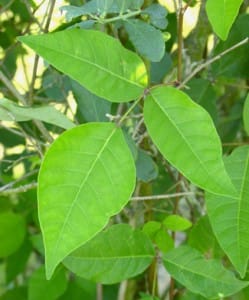Source(s): Mark Czarnota, UGA Weed Specialist
Everyone who works outdoors with plants or goes hiking, camping, picnicking or other outdoor activities should be able to identify poison ivy. Failing to know it when you see it can lead to severe allergic reactions. Poison ivy and its Rhus cousins are said to cause more contact dermatitis (redness, rash, blisters and itching) in the United States than all other plants and industrial or household chemicals.
Poison ivy (Rhus radicans) is found mostly in moist, deciduous forests and wooded areas. Unfortunately, it’s also found on trees, fences and ornamental plantings in Georgia landscapes. A related species, poison oak (Rhus toxicodendron), may actually be a type of poison ivy. Poison ivy may grow as a small shrub or a high-climbing vine on trees, fences and buildings. Each compound leaf has three bright green, shiny leaflets.
 Remember the rule
Remember the rule
The shape of the leaves and presence of hairs on the undersides vary greatly, so people may not always recognize poison ivy. The old saying, “leaflets three, let it be,” is a good rule. Poison ivy produces small flowers with five yellowish-green petals arranged on slender stalks. Its small, grayish white berries are food for more than 55 bird species.
Box elder (Acer negundo) is often confused with poison ivy. Its seedlings have three leaflets, too, but they have opposite leaves. Poison ivy leaves are alternately arranged on the stem. Virginia creeper (Parthenocissus quinquefolia) is also commonly confused with poison ivy. However, it is a harmless plant that has five leaflets growing out of one point where they are attached to the vine. Virginia creeper has blue berries. It is found growing in the home surroundings on houses, fences, trees, and in other places where poison ivy is observed.
All parts are poison
All parts of poison ivy are poisonous year-round. A toxic, oily compound (urushiol) is quickly exuded if plant tissues are broken in any way. People are exposed as they brush against the plant or touch equipment, clothes or pets that have touched it. It can even be carried in the smoke from burning the vines.
Only the oily toxin, though, can spread the rash. Symptoms usually appear in 12 to 48 hours but may not show up for days. If you think you’ve contacted poison ivy, washing your skin with cold water within 5 minutes may keep the urushiol from contacting your skin. Within the first 30 minutes, use soap and water. Consult a physician or pharmacist for the best treatment.
Can you dig it?
Digging poison ivy plants and roots can control it in small beds of landscape ornamentals. Be sure to wear watertight gloves, though. Continually clipping poison ivy at or near the ground will eventually control it. But you may have to clip it several times during the year for several years.
Chemical control
Herbicides can control poison ivy, too. But always read all label directions. Poison ivy has extensive roots, so you’ll likely have to apply herbicides many times. Glyphosate is the active ingredient in Roundup and many other products. Apply it directly to the foliage of poison ivy. It works well on warm, sunny days when plants are actively growing. It’s best when plants are flowering or fruiting, generally in early summer in Georgia.
You’ll need at least one rain-free hour after applying glyphosate to get the best results. The product can severely injure desirable plants, so don’t spray it on windy days. Use coarse sprays with large droplets to minimize drift.
Cut and spray
Where poison ivy has grown into large trees, cut the vine 2 to 3 feet above the soil. Within 24 hours, spray the leaves of the lower section (if any) with a 5-percent to 10-percent glyphosate solution (using at least a 41-percent glyphosate concentrate to make the spray solution).
If there are no leaves, paint or spray the lower stem portion with 50-50 glyphosate-water solution or undiluted glyphosate (with at least a 41-percent glyphosate concentrate.
Triclopyr (Brush-B-Gon, Brush Killer Plus) is recommended around homes, fences and nongarden areas. It’s often used to keep poison ivy and other plants from coming back after being cut. Just clip the poison ivy vine near the soil surface. Then paint the freshly cut surface with undiluted triclopyr. Don’t apply it, however, to the bark of any trees. Repeat the treatment when regrowth appears.
Resource(s): Poisonous Plants in the Landscape
Center Publication Number: 194
- Florida Betony Control - September 24, 2013
- Poison Ivy: Leaves of Three – Let it Be! - September 23, 2013
- Dodder - September 23, 2013